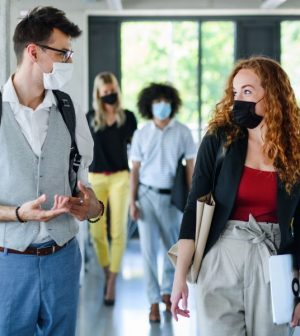- Navigating Your Midlife Crisis: Embracing New Possibilities
- City Raccoons Showing Signs of Domestication
- Mapping the Exposome: Science Broadens Focus to Environmental Disease Triggers
- One Week Less on Social Media Linked to Better Mental Health
- Your Brain Changes in Stages as You Age, Study Finds
- Some Suicide Victims Show No Typical Warning Signs, Study Finds
- ByHeart Formula Faces Lawsuits After Babies Sickened With Botulism
- Switch to Vegan Diet Could Cut Your Greenhouse Gas Emissions in Half
- Regular Bedtime Does Wonders for Blood Pressure
- Dining Alone Could Mean Worse Nutrition for Seniors
3 Steps Could Nearly Eliminate COVID Infections on College Campuses: Study

A combination of mask use, social distancing and routine testing would eliminate nearly all COVID-19 infections on U.S. college campuses, a new study claims.
Using a computer model that simulated a semester of a mid-sized college (5,000 students and 1,000 faculty), researchers assessed the effectiveness and cost of 24 combinations of four common preventive strategies: social distancing; mask-wearing; testing; and isolation.
A combination of just two measures — distancing and mandatory masks — would prevent 87% of campus COVID-19 infections and cost only $170 per infection prevented, according to the study.
Adding routine lab-based testing to the mix would prevent 92% to 96% of COVID-19 infections, but would increase the cost to between $2,000 and $17,000 per infection prevented.
With no prevention, about three-quarters of students and nearly one in six faculty members would become infected over the semester. Minimal social distancing policies would reduce infections by only 16% in students.
Closing the campus and switching to online-only education would reduce infections by 63% among students, but that would be less effective than keeping the campus open and having a combined mask-wearing and social distancing policy, which would reduce infections by 87% among students, according to the report published online recently in the Annals of Internal Medicine.
“While some measures are highly effective, implementing them is entirely up to each college’s financial situation, which may have already become strained because of the pandemic,” said study co-senior author Pooyan Kazemian, an assistant professor of operations at Case Western Reserve University’s School of Management, in Cleveland.
“It is clear that two common non-medical strategies are very effective and inexpensive — and allow for some in-person instruction,” Kazemian said in a university news release.
“While it’s true routine testing of the asymptomatic helps catch some infections early and reduce transmissions, they also pose the highest financial and operational burden, even if performed every 14 days,” he added.
“While states have started offering COVID-19 vaccine to health care workers, first responders and long-term care facilities, it is unlikely that most students and university faculty and staff will be offered a vaccine until late in the spring semester,” Kazemian said.
“Therefore, commitment to mask-wearing and extensive social distancing, including canceling large gatherings and reducing class sizes with a hybrid education system, remains the primary strategy for minimizing infections and keeping the campus open during the spring semester,” he concluded.
More information
The U.S. Centers for Disease Control and Prevention has more on COVID-19.
SOURCE: Case Western Reserve University, news release, Jan. 13, 2021
Source: HealthDay
Copyright © 2025 HealthDay. All rights reserved.










